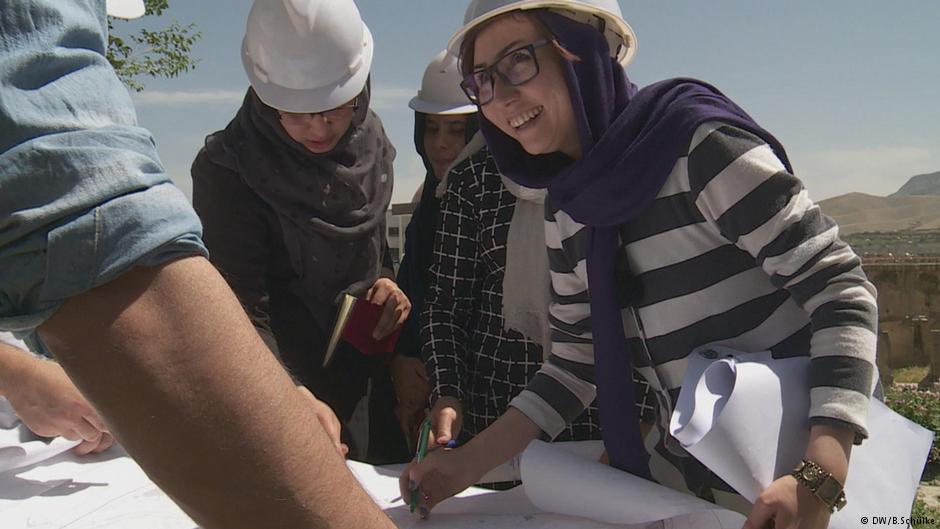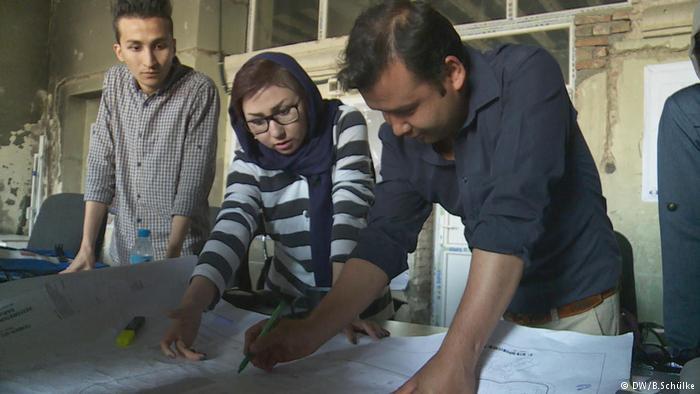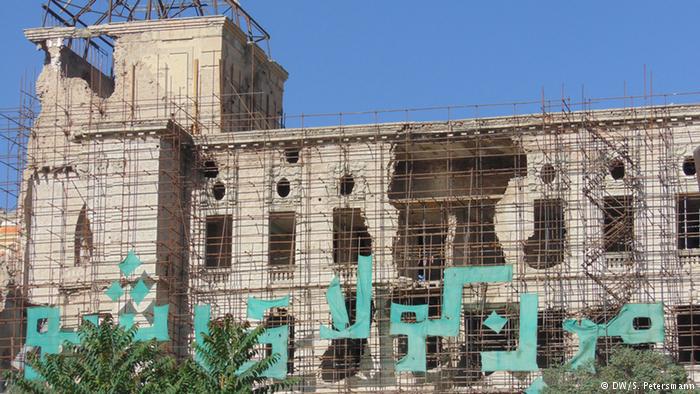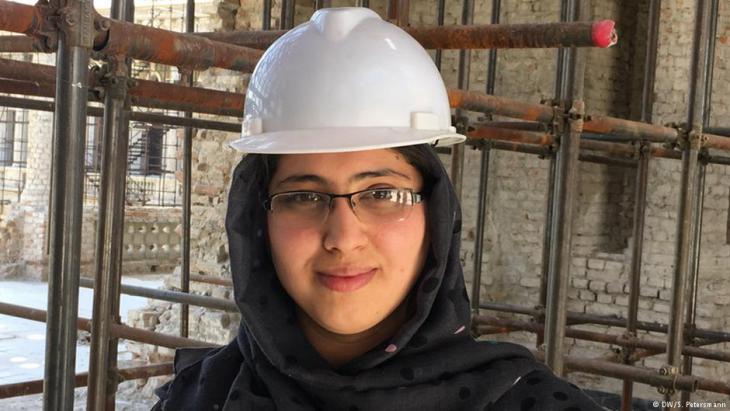Reconstruction in Afghanistan: The strong women of Darul Aman

Big holes, little holes, shredded walls: a seemingly infinite number of shells must have ripped through Kabul's neoclassical Darul Aman Palace, but it is still standing. A sand-coloured structural skeleton behind scaffolding gives a small hint of the once-opulent palace's former splendour.
"We can do it" is written in enormous letters on a sign that hangs from the scaffolding on the three-story building. Twenty-six year-old Wazhma Kurram sees the statement from far away as she arrives to work each day by bus or taxi. A quarter of the architects and engineers who have spent the past year working to restore the former parliament are women; their large contingent is immediately conspicuous.
Afghan President Ashraf Ghani had insisted upon the quota to ensure that women were represented in the reconstruction. Behind the walls of the palace, there are few conflicts between genders. Still, Kurram is often harassed on her way to work. Men on the street often insult her. Independent career women are still rare in Afghanistan – especially women in technical careers.
"That's how our society is," Kurram said. "You have to learn to live with it. I just ignore it. If I answered back, those guys would just be getting what they wanted. But, if I ignore them, it's like punishment."

The reconstruction of the Darul Aman Palace is Kurram's first job as a full-fledged structural engineer. "Here we can prove we are capable of rebuilding what we destroyed," she said. "The younger generation has the power to correct the mistakes of the past. Moreover, this is our cultural heritage: We have to preserve it."
From palace to ruin
In a darkened room in one wing of the palace, some 50 young architects and engineers intently plan the reconstruction on their laptops. Most bring their own computers and have acquired their own technical software. Improvisation is just as much part of this state-sponsored project as overtime is.
Outside, a few dozen workers use hammers and shovels to knock loose masonry from the walls and then haul away the rubble. There are no machines on site. The oldest of these workers is Mohammad Amin. He tells me that one of his sons fled to Germany four years ago. "If you take a sick man to the doctor, he hopes to be healed," Amin said.
"We hope to be healed, too," he adds, lumbering off with his wheelbarrow to get another load of rubble. The pace here is anything but hectic.
The construction of the Darul Aman Palace, which means "place of peace", was ordered in the 1920s by Afghanistan's reform-minded King Amanullah Khan. Plans were drawn up for the building on the western edge of Kabul by a team of Germans led by the architect Walter Harten.

The king wanted to open his country to the world after it achieved independence from Britain. The palace was intended to house Afghanistan's parliament, but Khan was driven from power by an uprising of religious hard-liners. Today, the once-prestigious address has become a symbol of the endless cycle of war that has plagued Afghanistan. Reconstruction of the palace is an entirely Afghan project and is intended as a reminder of better times.
Reconstruction in the midst of war
Hardly a day goes by in which a bomb does not explode somewhere in Afghanistan: car bombs, truck bombs, human bombs. Does it make sense to reconstruct a ruined palace in the midst of war, violence and terrorism? "Sure I'm scared," Kurram said. "Often, we don't know if we will get home alive. That's how our life is. But that doesn't mean we can sit at home despondent and doing nothing."
Some have ventured that it would be better to leave the ruins as a reminder of the horrors of war. In a country in which people are killed, starve or flee each day, such a massive restoration project could be seen as cynical.
"We have to think positively," Kurram said. "I know that a lot of people are disappointed and don't think that anything will ever change. But I have hope because I have faith in this new generation. I believe in our strength and in our ideas. There are really a lot of people here who want to change our country."
The palace was the headquarters of the Defence Ministry when the Soviet Army marched into Afghanistan in the late 1970s. Ten years later, the Red Army withdrew – run off by the Afghan mujahideen. Kurram was born during an era when brutal fratricidal war broke out between the factions that had been conscripted – and armed – by the United States and its allies to fight the Soviets.
After they defeated the occupiers, however, mujahideen groups were unable to come to an agreement to share power. Their battles for control destroyed Kabul while the United States and West European nations looked on. The palace eventually deteriorated into an embrasure and a backstop for bullets.
Ongoing urban warfare terrorised residents in Kabul for years and did not end until the Taliban arrived in the city in 1996. Kurram, her two sisters and their brother grew up under the totalitarian regime led by the religious scholar Mullah Mohammed Omar. That period had a profound effect on Kurram.
The job at the palace is her first since graduating from university. "My biggest aim in life is to make my parents proud," she said. "In the days of the Taliban, it was extremely difficult for us girls: we were not even allowed to attend school. But our parents always saw to it that our education was not compromised. They had teachers come educate us at home. I am an engineer today thanks to my parents."

She was 10 years old when the United States and its allies marched into Afghanistan after the terror attacks of 11 September 2001. Kurram's ruined city then became the centre of the international mission. New schools and universities offered new educational opportunities. Kurram studied maths and structural engineering.
"Education is the only way out," Kurram said. "Those who are educated understand the destructive power of war. And, if future generations grow up with new ideas, the war will finally end."
An uncertain future
There is currently nothing to suggest a peaceful solution to Afghanistan's conflicts. The government is divided and controls less than 60 percent of the country. Conflicts are raging in 31 of the country's 34 provinces. Some 1.5 million people are internally displaced. The Taliban, al-Qaida, Islamic State and various marauding militia groups are all threats. Corruption is destroying the state from within.
The political and power elite in Kabul has holed itself up behind ever higher and ever thicker blast walls, while everyone else is trapped on the constantly moving front lines. The reconstruction of Darul Aman is also taking place behind high concrete walls.
President Ghani has called reconstructing the palace his top priority. He intends to celebrate the 100th anniversary of Afghanistan's independence there in two year's time. When the restoration is complete, the palace will house visiting foreign dignitaries and provide a permanent site for a new national museum.
The supreme court is also expected to move in. The government has pledged about $20 million (18 million euros) for the project. Years ago, U.S. experts suggested that it would take $200 million to complete the reconstruction. The U.S. government has so far given $20 million of its own.
Up on the bullet-riddled roof of the palace ruins, chief architect Masouma Delijam looks out into the distance. An Afghan flag flutters from a rusty flagpole and a pink plastic bag dances to-and-fro in the wind. Across the way, the copper cupola of the new parliament building gleams in the midday sun. Neighbouring India financed the new building.
"It feels great to be up here on the roof of the palace," Delijam said. The 28-year-old grew up as a refugee in neighbouring Iran and moved back to Afghanistan in 2004. She gave up a well-paid private sector job to take part in the Darul Aman Palace's reconstruction.
"I have this dream that one day I will be able to walk here with my husband and my little son," Delijam says with tears in her eyes. "And that I will be able to tell my son that his parents rebuilt Darul Aman because we were so full of hope for Afghanistan."
Sandra Petersmann
© Deutsche Welle 2017